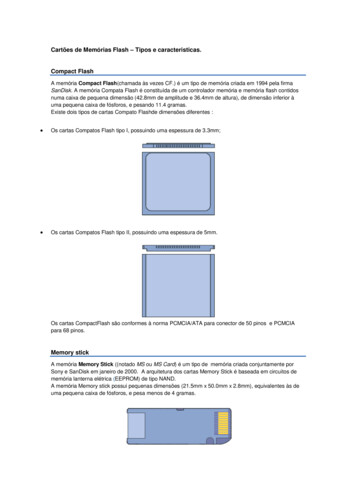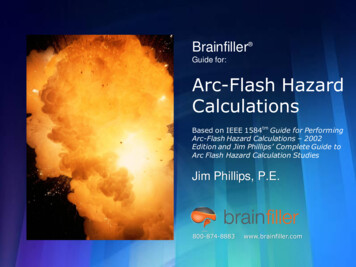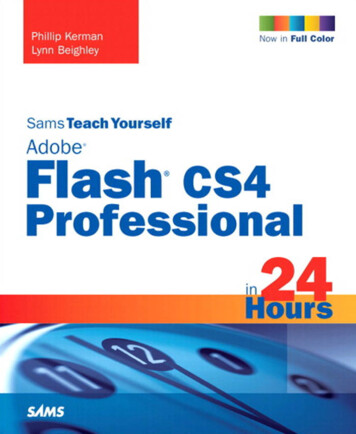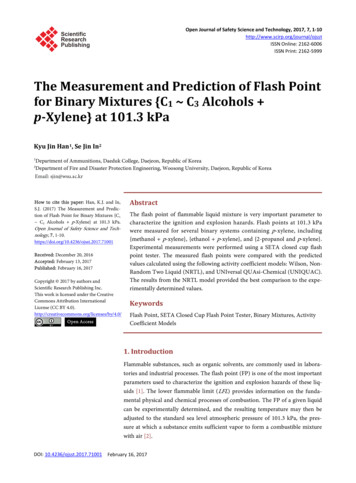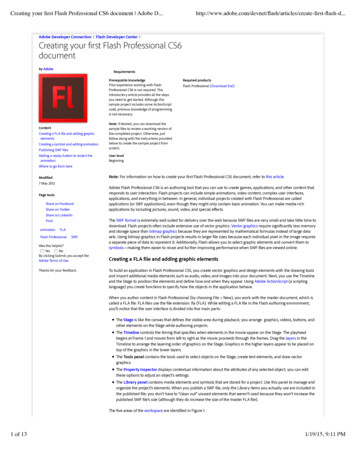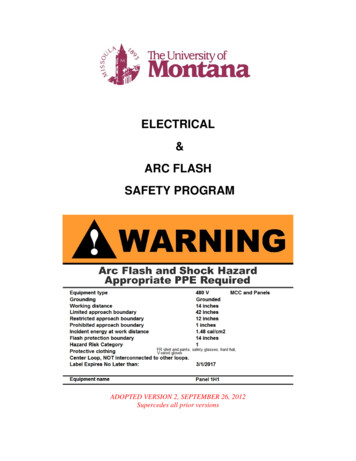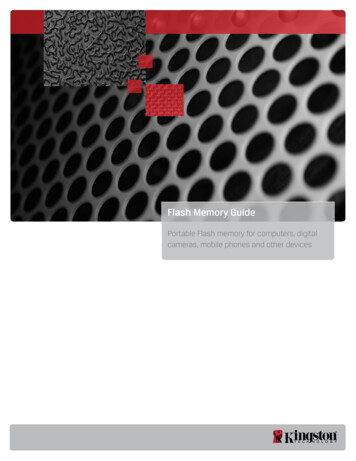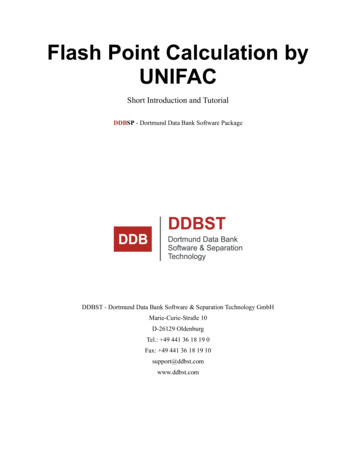
Transcription
Flash Point Calculation byUNIFACShort Introduction and TutorialDDBSP - Dortmund Data Bank Software PackageDDBST - Dortmund Data Bank Software & Separation Technology GmbHMarie-Curie-Straße 10D-26129 OldenburgTel.: 49 441 36 18 19 0Fax: 49 441 36 18 19 10support@ddbst.comwww.ddbst.com
DDBSP - Dortmund Data Bank Software Package1Introduction . 31.1Theoretical Background . 31.1.11.22Inert Components . 4Available Parameters . 4Using the Program . 52.1Toolbar Buttons . 62.2Component Management . 62.2.1Adding Missing Flash Point Data . 72.2.2Inert Components . 82.332020Check Interaction Parameter Availability . 8Calculating Flash Points. 103.1Standard or Custom Compositions .113.2Calculation Result .113.3Diagrams . 123.3.1Ternary Mixtures . 123.3.2Binary Mixtures . 123.4LLE Calculation . 13Flash Point Calculation by UNIFACPage 2 of 13
DDBSP - Dortmund Data Bank Software Package12020IntroductionThis software calculates flash points of flammable liquid mixtures by the UNIFAC based methods “originalUNIFAC”1, “modified UNIFAC (Dortmund)”2 and “NIST modified UNIFAC”3. All methods are delivered withthe latest published parameters.The algorithm to calculate the flash points is described in a scientific paper4 from 1982. The basic procedure isthat from known pure component properties (flash point and heat of combustion) the real behavior of the mixtureis estimated by the activity coefficients which are obtained from the predictive group contribution models orig.UNIFAC and modified UNIFAC (Dortmund). Additional needed parameters are Antoine coefficients for thecalculation of the saturated vapor pressures of pure components.1.1 Theoretical BackgroundThe flash point temperature of a pure combustible component is the temperature TF for which the saturated pressureis equal to the lower flammability limit:𝑃𝑖𝑆 1 𝑜𝑟 𝑃𝑖𝑆 𝐿𝑖𝐿𝑖with𝑃𝑖𝑆Saturated vapor pressure of component i𝐿𝑖Lower flammability limit of component iFor mixtures, this relation can be extended to𝑁 𝑖 1𝑃𝑖 1𝐿𝑖with𝑁Number of components𝑃𝑖Partial pressure of component i in a vapor-air mixture in equilibrium𝐿𝑖Partial pressure in a vapor-air mixture of component i corresponding to the lower flammability limit ofthe pure component.The temperature dependence of the lower flammability limit is estimated by the function𝐿𝑖 (𝑡) 𝐿𝑖 (25 𝐶) 0.182 𝑡 25 𝐻𝑐𝑖withWittig R., Lohmann J., Gmehling J., "Vapor-Liquid Equilibria by UNIFAC Group Contribution. 6. Revision andExtension", Ind.Eng.Chem.Res., 42(1), 183-188, 20032Jakob A., Grensemann H., Lohmann J., Gmehling J., "Further Development of Modified UNIFAC (Dortmund): Revisionand Extension 5", Ind.Eng.Chem.Res., 45(23), 7924-7933, 20063Constantinescu D., Gmehling J., "Further Development of Modified UNIFAC (Dortmund): Revision and Extension 6",J.Chem.Eng.Data, 61(8), 2738-2748, 2016.4Gmehling J., Rasmussen P., "Flash Points of Flammable Liquid Mixtures Using UNIFAC.", Ind.Eng.Chem. Fundam.,21(2), 186-188, 19821Flash Point Calculation by UNIFACPage 3 of 13
DDBSP - Dortmund Data Bank Software Package2020𝐿𝑖 (𝑡)Lower flammability limit at temperature t in C of component i𝐿𝑖 (25 𝐶)Lower flammability limit at temperature 25 C (tabulated, stored) of component i𝐻𝑐𝑖Heat of combustion of component i in kJ/mol typically.The partial pressures at vapor-liquid equilibrium conditions 𝑃𝑖 can be calculated by𝑃𝑖 𝑥𝑖 𝛾𝑖 𝑃𝑖𝑆when the vapor-air mixture behaves as an ideal gas.𝑥𝑖Mole fraction of component i𝛾𝑖Activity coefficient of component i at a given temperature𝑃𝑖𝑆Saturated vapor pressure of component i at a given temperatureThe activity coefficients 𝛾𝑖 are calculated by UNIFAC, the saturated vapor pressure of the pure components by theAntoine equation.The flash point temperature TF can now be calculated by iterating this equation to fulfill the condition 𝑁𝑖 1𝑃𝑖𝐿𝑖 1.1.1.1 Inert ComponentsInert (non-combustible) components like water in the mixture reduce the partial pressures 𝑃𝑖 of the combustiblecomponents. This leads to a higher flash point temperature because the vapor pressure needed for the ignition ofthe combustible components is obtained at higher temperatures. Additionally, inert components change the activitycoefficients of the combustible components leading also to different partial pressures.1.2 Available ParametersThe software includes flash point temperatures for 1229 components heats of combustion for 1710 components flash point temperatures and heats of combustion for 453 components (both needed values are available) Antoine coefficients for approx. 6250 components original UNIFAC group assignments for approx. 26,750 components mod. UNIFAC (Dortmund) group assignments for approx. 30,850 components.Flash points and heats of combustion can be entered directly in the program for every component. Antoinecoefficients and group assignments are directly taken from data files and can be altered or added for privatecomponents.Flash Point Calculation by UNIFACPage 4 of 13
DDBSP - Dortmund Data Bank Software Package22020Using the ProgramThe graphical user interface contains four major parts: A tool bar with command buttons Several controls for the component management A panel with controls for the calculation, model selection, and data display A grid for the resultsComponents SelectionList of ComponentsStart CalculationCheck for Availabilityof the Parameters of theGroup Contribution MethodPure component propertyeditor.ModelSelectionResult andAvailable Data DisplayFigure 1: Graphical user interfaceThe result grid itself has a tool button bar which allows copying and saving the grid content.Flash Point Calculation by UNIFACPage 5 of 13
DDBSP - Dortmund Data Bank Software Package20202.1 Toolbar Buttons The button “Exit” closes the program. “Component Editor” executes the separate program for editing basic component data. “Interaction Parameters” execute the program that displays the interaction and other parameters for themodels. “DDB Configuration” executes the program for the DDB configurations (paths and settings etc.). The button “About” displays the accordant dialog.2.2 Component ManagementThe component grid shows the DDB number, a typical name, the empirical formula, the molecular weight, flashpoint and heat of combustion of the different components.This component management uses the standard list of components in the Dortmund Data Bank. The componentselection is done in the component selection program which is described in a separate PDF (see“ComponentManagement.pdf”).The “Add Component” button calls the component selection program:Figure 2: Component selection dialog.Here it is possible to search the complete component file of the Dortmund Data Bank by names, formula, etc. Theedit field below the “Add Component” button allows the input of components by DDB numbers directly. This isuseful after some experience with the DDB component list and the knowledge of the DDB numbers of the maincomponents.Flash Point Calculation by UNIFACPage 6 of 13
DDBSP - Dortmund Data Bank Software Package20202.2.1 Adding Missing Flash Point DataThe component grid displays information about The DDB code number A typical component name The empirical formula The molecular weight Flash point temperature in [K] Heat of combustion in [kJ/mol]The last both cells are editable and allow entering new values for both the pure components flash point temperatureand the heat of combustion. Fragmentation and Antoine coefficients for private components can be changed / fittedby pressing the “Component Editor” button. A new window pops up and shows the pure component properties ofthe marked component:Figure 3: View and edit pure component properties.Flash Point Calculation by UNIFACPage 7 of 13
DDBSP - Dortmund Data Bank Software Package20202.2.2 Inert ComponentsInert components are added like normal components. Inert components are recognized by the missing flash pointtemperature and heat of combustion.2.3 Check Interaction Parameter AvailabilityThis function checks if the activity coefficients of the defined mixture can be calculated with the group contributionmodels. The dialog has two pages – the first with an overview if the calculation is possible or notFigure 4: Check for available interaction parameters and group assignments.and the second page with details about the group assignments (sub and main groups) and the interactionparameters.UNIFACComponentComponent11: EthanolSubgroups:1 (CH321: Ethyl acetateSubgroups:1 (CH3List of Main GroupsMaingroups:1 (CH2Interaction1 5:1 - 11:5 - 11:)parameters1 parameter/s1 parameter/s1 parameter/s5 (OH(CH2(CH2(OH)2 (CH2)14 (OH))2 (CH2)21 (CH3COO))11 (CCOO/ OH/ CCOO/ CCOO))))System has all parameters available.mod. UNIFAC (Dortmund)ComponentComponent11: EthanolSubgroups:1 (CH321: Ethyl acetateSubgroups:1 (CH3Flash Point Calculation by UNIFAC)2 (CH2)14 (OH (P)))2 (CH2)21 (CH3COO)Page 8 of 13
DDBSP - Dortmund Data Bank Software PackageList of Main GroupsMaingroups:1 (CH2Interaction1 5:1 - 11:5 - 11:)parameters3 parameter/s3 parameter/s3 parameter/s5 (OH(CH2(CH2(OH2020)11 (CCOO/ OH/ CCOO/ CCOO))))System has all parameters available.NIST-mod. UNIFACComponentComponent11: EthanolSubgroups:1 (CH321: Ethyl acetateSubgroups:1 (CH3List of Main GroupsMaingroups:1 (CH2Interaction1 5:1 - 11:5 - 11:)parameters3 parameter/s3 parameter/s3 parameter/s5 (OH(CH2(CH2(OH)/ OH/ CCOO/ CCOO)2 (CH2)14 (OH prim ))2 (CH2)21 (CH3COO11 (CCOO)))))System has all parameters available.This example shows that all models can be used to calculate activity coefficients.Flash Point Calculation by UNIFACPage 9 of 13
DDBSP - Dortmund Data Bank Software Package32020Calculating Flash PointsThe button “Calculate Flashpoint” will calculate the flash points for given composition. A dialog pops up wherecompositions can be entered:Figure 5: CompositionWanted compositions can either be entered directly in the data grid or automatically created by the “Create DataPoints” button.For the automatic creation, it is possible to specify lower and upper limits of compositions and the step width. Formixture with three or more components it is possible to specify constant compositions or constant mole fractionratios.Figure 6: Options for the automatic data point creation.The created data points will be displayed in the data gridFlash Point Calculation by UNIFACPage 10 of 13
DDBSP - Dortmund Data Bank Software Package2020Figure 7: Automatically created compositions.and can be copied to the Windows clipboard or saved as CSV files (Comma Separated Values). If data are availablein other programs (like spread sheets) or on disk the data table can be pasted or loaded.The “Use These Data Points” button closes this dialog and starts the calculation, the “Close” also closes this dialogbut does not start the calculation (like “Cancel”).3.1 Standard or Custom CompositionsIt is possible to calculated just 21 points in 5 mole-% steps and without specifying the compositions manually byswitching the option “Custom Compositions” off.3.2 Calculation ResultThe data grid contains three parts.The compositions are the composition either entered manually or created automatically. The flash pointtemperatures and the activity coefficients are calculated values.The content of this data table can either be copied to the Windows clipboard or saved as Microsoft Excel 2007files (extension “xls”).Flash Point Calculation by UNIFACPage 11 of 13
DDBSP - Dortmund Data Bank Software Package20203.3 DiagramsDiagrams are available for binary and ternary mixtures. Typical results are shown in this chapter.3.3.1 Ternary MixturesFigure 8: Flashpoint diagram of a ternary mixture.3.3.2 Binary MixturesFigure 9: Flashpoint diagram of a binary mixture.A description of the plot program is available separately (“DDBPlot.pdf”).Flash Point Calculation by UNIFACPage 12 of 13
DDBSP - Dortmund Data Bank Software Package20203.4 LLE CalculationThe program allows the calculation of miscibility gaps (liquid-liquid equilibria) for binary mixtures only. If a LLEis found, no flash point is calculated and the compositions in the data grid are set to light red.Figure 10: Result table with marked LLE.In binary diagrams the LLE area is shown as a straight horizontal line:Figure 11: Plot of the calculation results.The LLE is not determined exactly. Instead all given compositions are tested if they are inside the miscibility gap.Flash Point Calculation by UNIFACPage 13 of 13
The button "Calculate Flashpoint" will calculate the flash points for given composition. A dialog pops up where compositions can be entered: Figure 5: Composition Wanted compositions can either be entered directly in the data grid or automatically created by the "Create Data Points" button.

